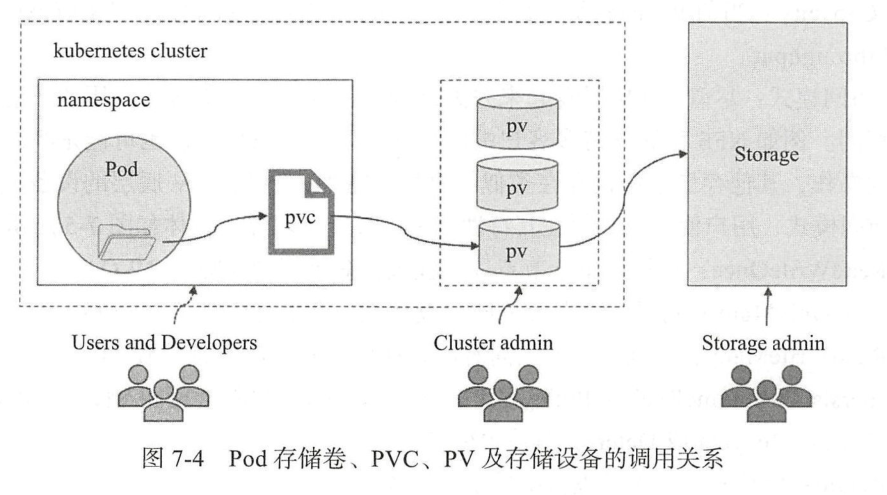Kubernetes进阶实战读书笔记:持久化存储卷(pv详解)
一、Pod存储卷、PVC、PV及存储设备的调用关系

二、PV对存储系统的支持可通过插件来实现、目前Kubernetes支持如下类型的插件
1 2 3 4 5 6 7 8 9 10 11 12 13 14 15 16 17 18 19 20 | GCEPersistentDiskAWSElasticBlockStoreAzureFileAzureDiskCSIFC (Fibre Channel)FlexVolumeFlockerNFSiSCSIRBD (Ceph Block Device)CephFSCinder (OpenStack block storage)GlusterfsVsphereVolumeQuobyte VolumesHostPath (Single node testing only -- local storage is not supported in any way and WILL NOT WORK in a multi-node cluster)Portworx VolumesScaleIO VolumesStorageOS |
三、PersistentVolume Spec通用字段详解
1、存储能力(Capacity)
1 2 3 4 5 | Generally, a PV will have a specific storage capacity. This is set using the PV's capacity attribute. See the Kubernetes Resource Model to understand the units expected by capacity.#当前pv的容量;目前Capacity仅支持空间设定Currently, storage size is the only resource that can be set or requested. Future attributes may include IOPS, throughput, etc.#将来应该还可以指定IOPS和throughput |
2、存储卷模式(Volume Mode)
1 2 3 4 5 6 7 8 9 | FEATURE STATE: Kubernetes v1.18 [stable]Kubernetes supports two volumeModes of PersistentVolumes: Filesystem and Block.volumeMode is an optional API parameter. Filesystem is the default mode used when volumeMode parameter is omitted.A volume with volumeMode: Filesystem is mounted into Pods into a directory. If the volume is backed by a block device and the device is empty, Kuberneretes creates a filesystem on the device before mounting it for the first time.You can set the value of volumeMode to Block to use a volume as a raw block device. Such volume is presented into a Pod as a block device, without any filesystem on it. This mode is useful to provide a Pod the fastest possible way to access a volume, without any filesystem layer between the Pod and the volume. On the other hand, the application running in the Pod must know how to handle a raw block device. See Raw Block Volume Support for an example on how to use a volume with volumeMode: Block in a Pod#卷模型、用于指定此卷可被用作文件系统还是裸格式的块设备;默认为Filesysyem |
3、存储类别(Class)
PV可以设定其存储的类别,通过storageClassName参数指定一个StorageClass资源对象的名称。具有特定类别的PV只能与请求了该类别的PVC进行绑定。未设定类别的PV则只能与不请求任何类别的PVC进行绑定
4、回收策略(Reclaim Policy)
1 2 3 4 5 6 7 | Current reclaim policies are:#pv空间被释放时的处理机制;可用类型仅为Retain、Recycle、DeleteRetain -- manual reclamation #保持不动、由管理员随后手动回收Recycle -- basic scrub (rm -rf /thevolume/*) #空间回收、即删除存储卷目录下的所有文件(包含子目录和隐藏文件)、目前仅NFS和hostPath支持此操作Delete -- associated storage asset such as AWS EBS, GCE PD, Azure Disk, or OpenStack Cinder volume is deleted #删除存储卷、仅部分云端存储系统支持、如AWS EBS、GCE PD、Azure Disk和CinderCurrently, only NFS and HostPath support recycling. AWS EBS, GCE PD, Azure Disk, and Cinder volumes support deletion |
目前,只有NFS和HostPath两种类型的存储支持Recycle策略;AWS EBS、GCE PD、Azure Disk和Cinder volumes支持Delete策略。
5、挂载参数(Mount Options)
目前,以下PV类型支持设置挂载参数:
1 2 3 4 5 6 7 8 9 10 11 12 13 | AWSElasticBlockStoreAzureDiskAzureFileCephFSCinder (OpenStack block storage)GCEPersistentDiskGlusterfsNFSQuobyte VolumesRBD (Ceph Block Device)StorageOSVsphereVolumeiSCSI |
四、PersistentVolume Spec访问模式(Access Modes)详解
1、访问模式(Access Modes)
1 2 3 4 5 6 7 8 9 10 11 12 | A PersistentVolume can be mounted on a host in any way supported by the resource provider. As shown in the table below, providers will have different capabilities and each PV's access modes are set to the specific modes supported by that particular volume. For example, NFS can support multiple read/write clients, but a specific NFS PV might be exported on the server as read-only. Each PV gets its own set of access modes describing that specific PV's capabilities.尽管在pv层看起来并无差别,但存储设备支持及启动的功能特性却可能不尽相同。例如NFS存储支持多客户端同时挂在及读写操作、但也可能是在共享时仅启用了只读操作,但也可能是在共享时仅启用了指读操作、其他存储系统也存在类似的可配置特性、因此PV顶层的设备或许存在其特有的访问模式,用户使用时必须在其特性范围内设定其功能,具有同如图7所示The access modes are:ReadWriteOnce -- the volume can be mounted as read-write by a single node #仅可被单节点读写挂载ReadOnlyMany -- the volume can be mounted read-only by many nodes #可被多个节点同时只读挂载ReadWriteMany -- the volume can be mounted as read-write by many nodes #可被多个节点同时读写挂载In the CLI, the access modes are abbreviated to:RWO - ReadWriteOnce #命令行可简写为RWOROX - ReadOnlyMany #命令行可简写为ROXRWX - ReadWriteMany #命令行可简写为RWX |
2、个PV支持的访问模式


四、创建pv
1、NFS示例模板
1 2 3 4 5 6 7 8 9 10 11 12 13 14 15 16 17 18 19 20 21 | [root@master chapter7]# cat pv-nfs-0001.yaml apiVersion: v1kind: PersistentVolumemetadata: name: pv-nfs-0001 labels: release: stablespec: capacity: storage: 5Gi volumeMode: Filesystem accessModes: - ReadWriteMany persistentVolumeReclaimPolicy: Recycle storageClassName: slow mountOptions: - hard - nfsvers=4.1 nfs: path: "/webdata/htdocs" server: nfs.ikubernetes.io |
2、创建状态查看
1 2 3 4 5 6 7 8 | [root@master chapter7]# kubectl apply -f pv-nfs-0001.yaml persistentvolume/pv-nfs-0001 created[root@master chapter7]# kubectl get pvNAME CAPACITY ACCESS MODES RECLAIM POLICY STATUS CLAIM STORAGECLASS REASON AGEpv-nfs-0001 5Gi RWX Recycle Available slow 19s[root@master chapter7]# kubectl get pv pv-nfs-0001 -o custom-columns=NAME:metadata.name,STATUS:status.phaseNAME STATUSpv-nfs-0001 Available |
3、rbd存储后端示例模板
1 2 3 4 5 6 7 8 9 10 11 12 13 14 15 16 17 18 19 20 21 22 23 24 25 26 | [root@master chapter7]# cat pv-rbd-0001.yaml apiVersion: v1kind: PersistentVolumemetadata: name: pv-rbd-0001 labels: release: "stable"spec: capacity: storage: 2Gi accessModes: - ReadWriteOnce storageClassName: fast rbd: monitors: - 172.16.0.56:6789 - 172.16.0.57:6789 - 172.16.0.58:6789 pool: kube image: pv-rbd-0001 user: admin secretRef: name: ceph-secret fsType: ext4 readOnly: false persistentVolumeReclaimPolicy: Retain |
创建运行
1 2 3 4 5 6 | [root@master chapter7]# kubectl apply -f pv-rbd-0001.yaml persistentvolume/pv-rbd-0001 configured[root@master chapter7]# kubectl get pvNAME CAPACITY ACCESS MODES RECLAIM POLICY STATUS CLAIM STORAGECLASS REASON AGEpv-nfs-0001 5Gi RWX Recycle Bound default/pvc-nfs-0001 slow 14hpv-rbd-0001 2Gi RWO Retain Bound default/pvc-rbd-0001 fast 3m58s |
4、PV空间被释放时的处理机制
1 2 3 4 5 6 7 8 | A volume will be in one of the following phases:Available -- a free resource that is not yet bound to a claim #可用状态,还未与某个PVC绑定Bound -- the volume is bound to a claim #已与某个PVC绑定Released -- the claim has been deleted, but the resource is not yet reclaimed by the cluster #绑定的PVC已经删除,资源已释放,但没有被集群回收。Failed -- the volume has failed its automatic reclamation #因自动资源回收失败而处于的故障状态The CLI will show the name of the PVC bound to the PV |
作者:罗阿红
出处:http://www.cnblogs.com/luoahong/
本文版权归作者和博客园共有,欢迎转载,但未经作者同意必须保留此段声明,且在文章页面明显位置给出原文连接。
分类:
云计算Kubernetes



【推荐】国内首个AI IDE,深度理解中文开发场景,立即下载体验Trae
【推荐】编程新体验,更懂你的AI,立即体验豆包MarsCode编程助手
【推荐】抖音旗下AI助手豆包,你的智能百科全书,全免费不限次数
【推荐】轻量又高性能的 SSH 工具 IShell:AI 加持,快人一步
· 10年+ .NET Coder 心语,封装的思维:从隐藏、稳定开始理解其本质意义
· .NET Core 中如何实现缓存的预热?
· 从 HTTP 原因短语缺失研究 HTTP/2 和 HTTP/3 的设计差异
· AI与.NET技术实操系列:向量存储与相似性搜索在 .NET 中的实现
· 基于Microsoft.Extensions.AI核心库实现RAG应用
· TypeScript + Deepseek 打造卜卦网站:技术与玄学的结合
· 阿里巴巴 QwQ-32B真的超越了 DeepSeek R-1吗?
· 【译】Visual Studio 中新的强大生产力特性
· 10年+ .NET Coder 心语 ── 封装的思维:从隐藏、稳定开始理解其本质意义
· 【设计模式】告别冗长if-else语句:使用策略模式优化代码结构
2019-08-15 深入浅出计算机组成原理学习笔记:第四十三讲
2019-08-15 深入浅出计算机组成原理学习笔记:第四十二讲
2019-08-15 深入浅出计算机组成原理学习笔记:第三十七讲
2019-08-15 深入浅出计算机组成原理学习笔记:第三十九讲
2017-08-15 网络编程基础【day10】:IO多路复用